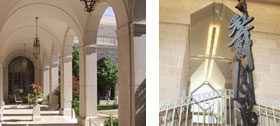Donna Strahan Joins Smithsonian’s Freer and Sackler Galleries as Head of Conservation and Scientific Research
MEDIA ONLY: Allison Peck, 202.633.0447
Press Asia
ONLINE: asia.si.edu/press, @FreerSackler
March 27, 2014
Donna Strahan has joined the Freer Gallery of Art and Arthur M. Sackler Gallery, the Smithsonian’s museums of Asian art, as the head of the Department of Conservation and Scientific Research, where she will oversee the conservation, care and preservation of the museums’ more than 35,000 works of art, representing more than 6,000 years of Asian art and culture. Strahan, who was most recently a conservator at the Metropolitan Museum of Art in New York, began her new role at the Freer and Sackler galleries March 24.
“The Department of Conservation and Scientific Research is a vibrant center for new techniques and ideas in Asian art conservation,” said Julian Raby, The Dame Jillian Sackler Director of the Arthur M. Sackler Gallery and Freer Gallery of Art. “As a leader in the field, Donna has already contributed to the study and care of objects in almost every form possible, from Japan to Turkey. We eagerly await her further work at the Freer and Sackler galleries.”
The Department of Conservation and Scientific Research at the Freer and Sackler galleries contains the Technical Laboratory, which was founded in 1951 and was the first Smithsonian facility to apply scientific methods to study works of art, and the East Asian Painting Conservation Studio, which was founded in 1932 and remains one of the few places in the United States to specialize in the conservation of Asian paintings. In addition to studying and treating works of art, and ensuring their stability when on view and travelling, Strahan will oversee the department’s varied and cutting-edge scientific research projects, which include studies on provenance, materials and artistic methods.
Strahan, whose specialty is ancient Asian bronzes and lacquers, worked at the Metropolitan Museum 2006–2014, where she was responsible for all conservation matters related to the research, treatment, storage and exhibition of Asian art. She was also previously head of conservation at the Asian Art Museum in San Francisco from 1999 to2006, where she supervised conservation staff, oversaw the design of conservation laboratories and participated in the move of the museum into new spaces. She is nationally and internationally recognized for her contributions to the field of conservation of Asian art objects and for furthering research with her knowledge of Chinese language and culture.
“I’ve spent many fascinating hours in the Freer and Sackler galleries and laboratory as a college student, never dreaming I would one day return as staff,” said Strahan. “The museum has long been a leader in the field of art conservation, and I’m very excited to join a deeply engaged institution that produces such consistently high standards of research publications, symposia and exhibitions. Due to Asia’s spectacular recent economic growth, there’s an increased awareness of the importance of artistic preservation and need for the national and international cooperative projects that are a hallmark of the Freer and Sackler galleries.”
Strahan has actively furthered the field both by working at major archaeological sites and by mentoring the next generation of conservators. She established a conservation laboratory at the archaeological excavation at Harappa in Pakistan and headed the laboratory at Troy in Turkey, where she worked for 18 summers, and has taught at the New York University Conservation Center, the Conservation Center at Erbil in Iraq and Sichuan University in China.
She has written numerous articles on topics ranging from technical studies on Chinese Buddhist sculpture and Thai bronzes to best practices for the field, such as safe handling guidelines for uranium used in glass and ceramic glazes. Strahan also worked as a conservator at the Walters Art Museum and has prior Smithsonian experience as conservator at the Conservation Analytical Laboratory (now the Museum Conservation Institute).
The Arthur M. Sackler Gallery, located at 1050 Independence Avenue S.W., and the adjacent Freer Gallery of Art, located at 12th Street and Independence Avenue S.W., are on the National Mall in Washington, D.C. Hours are 10 a.m. to 5:30 p.m. every day (closed Dec. 25), and admission is free. The galleries are located near the Smithsonian Metrorail station on the Blue and Orange lines. For more information about the Freer and Sackler galleries and their exhibitions, programs and other public events, visit www.asia.si.edu. For general Smithsonian information, call (202) 633-1000.
###

Exhibition Information
An American in London: Whistler and the Thames
May 3–August 17, 2014
Arthur M. Sackler Gallery
Contact us
pressasia@si.eduTel: 202.633.0271
Fax: 202.633.0046
Office of Marketing and Communications
Freer Gallery of Art and Arthur M. Sackler Gallery
PO Box 37012, MRC 707
Washington, DC 20013-7012
